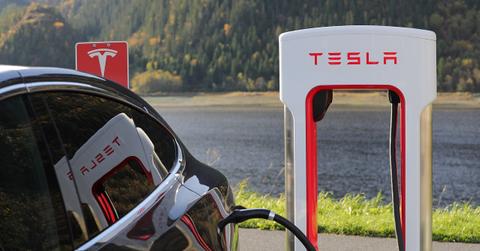Tesla Plans To Run Most Supercharger Stations On Solar And Battery Power
Tesla announced back in December that their upgraded Supercharger has the potential for powering cars off the electrical grid. Elon Musk updated through a social media exchange that nearly all of them would be off the grid with solar and battery energy.
Updated May 24 2019, 8:08 a.m. ET
Tesla is hoping to give plenty of house owners the ability to go off the grid, and now they’re in the process of doing the same with their Supercharger stations. An exchange on Twitter with Elon Musk revealed that nearly all of the charging centers could be ran on their own energy in the future. The move has been rendered as interesting according to industry experts.
The company’s CEO responded to a comment on Twitter that brought up the Supercharger station in Asheville, North Carolina, using a coal-fired power plant to generate electricity. The issue is that carbon emissions theoretically would still remain a problem for those that fueled up their electric vehicle at that station. He said that “all Superchargers are being converted to solar/battery power” and “almost all will disconnect from the electricity grid.”
Why “theoretically”? Just having that assumption is untrue based on actual research. There’s less carbon emissions coming from power plants that run on coal versus the internal combustion system in cars. However, most of that depends on the area and its electrical grid -- some are dirtier than others. For those arguing it would increase power plant production, the majority of consumers will charge their EVs at night and away from peak times.
It’s anticipated that Tesla-manufactured solar panels and battery options would be enough to fuel an entire charging station. Energy would be stored in Powerpacks, which are the utility and business edition of the company’s Powerwall product. This would all be achievable with the upgraded third version of the Supercharger.
With the announcement of the Supercharger upgrade back in December, Fred Lambert of Electrek queried Musk over power output. As competing charging stations were upgrading their output to 350 kilowatts (over 200 kilowatts better than current Superchargers), the CEO hinted that it could be bigger than that. There was also the reveal that some stations would disconnect from the grid if they are under “moderate use” in “non-snowy regions.”
That claim has since been updated to suggest that nearly all charging stations would run under their own power. This makes sense for smaller stations and areas that receive a ton of sunlight, but how would that be feasible for a stopping point that can charge double-digit EVs at the same time? After all, it’s one thing to power an entire home for a family of four, but it’s another to constantly fuel up these vehicles. Lambert also has his concerns.
"Depending on the size and popularity of a Supercharger station, which generally varies from 6 partly used stalls to 20 stalls in almost constant use, Tesla would need some significantly large solar arrays at some stations – almost football field in size. Unless there are some impressive advancements in efficiency, it’s not clear how they would make it happen."
Perhaps Tesla has the technology required to support a large fleet of Superchargers, or Musk is referring to this opportunity way down the road. He hasn’t released any timetable for when or where the company’s charging stations would be taken off the grid.
